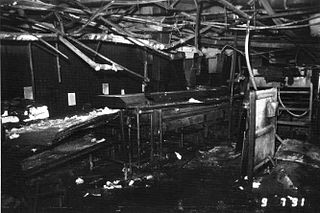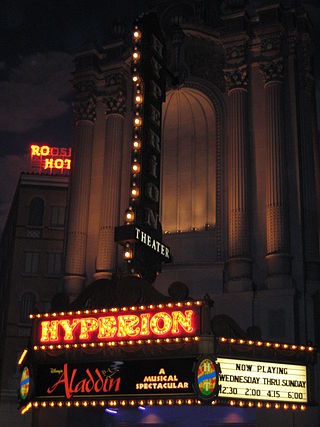Related Research Articles
The Occupational Safety and Health Administration is a regulatory agency of the United States Department of Labor that originally had federal visitorial powers to inspect and examine workplaces. The United States Congress established the agency under the Occupational Safety and Health Act, which President Richard M. Nixon signed into law on December 29, 1970. OSHA's mission is to "assure safe and healthy working conditions for working men and women by setting and enforcing standards and by providing training, outreach, education, and assistance." The agency is also charged with enforcing a variety of whistleblower statutes and regulations. OSHA's workplace safety inspections have been shown to reduce injury rates and injury costs without adverse effects on employment, sales, credit ratings, or firm survival.

A work accident, workplace accident, occupational accident, or accident at work is a "discrete occurrence in the course of work" leading to physical or mental occupational injury. According to the International Labour Organization (ILO), more than 337 million accidents happen on the job each year, resulting, together with occupational diseases, in more than 2.3 million deaths annually.

A confined space is a space with limited entry and egress and not suitable for human inhabitants. Alternative names for a confined space are enclosed space and dangerous space. An example is the interior of a storage tank, occasionally entered by maintenance workers but not intended for human occupancy. Hazards in a confined space often include harmful dust or gases, asphyxiation, submersion in liquids or free-flowing granular solids, electrocution, or entrapment.

Karen Elizabeth Wetterhahn, also known as Karen Wetterhahn Jennette, was an American professor of chemistry at Dartmouth College, New Hampshire, who specialized in toxic metal exposure. She died of mercury poisoning at the age of 48 due to accidental exposure to the extremely toxic organic mercury compound dimethylmercury. Protective gloves in use at the time of the incident provided insufficient protection, and exposure to only a few drops of the chemical absorbed through the gloves proved to be fatal after less than a year.
John Radford Froines was an American chemist and anti-war activist, noted as a member of the Chicago Seven, a group charged with involvement with the riots at the 1968 Democratic National Convention in Chicago. Froines, who held a Ph.D. in chemistry from Yale, was charged with interstate travel for purposes of inciting a riot and with making incendiary devices, but was acquitted. He later served as the Director of Toxic Substances at the federal Occupational Safety and Health Administration and then director of UCLA’s Occupational Health Center. He also served as chair of the California Scientific Review Panel on Toxic Air Contaminants for nearly 30 years before resigning in 2013 amid controversy and claims of conflict of interest.

tert-Butyllithium is a chemical compound with the formula (CH3)3CLi. As an organolithium compound, it has applications in organic synthesis since it is a strong base, capable of deprotonating many carbon molecules, including benzene. tert-Butyllithium is available commercially as solutions in hydrocarbons (such as pentane); it is not usually prepared in the laboratory.

On September 3, 1991, an industrial fire caused by a failed improvised repair to a hydraulic line destroyed the Imperial Food Products chicken processing plant in Hamlet, North Carolina. Despite three previous fires in 11 years of operation, the plant had never received a safety inspection. The fire killed 25 people and injured 54, many of whom were unable to escape due to locked exits. It was the second deadliest industrial disaster in North Carolina's history.

The Hyperion Theater is a theater located at Disney California Adventure in Hollywood Land. The theater can seat up to 1,984 people.
Anthony Mazzocchi was an American labor leader. He was a high elected official of the Oil, Chemical and Atomic Workers International Union (OCAW), serving as vice president from 1977 to 1988, and as secretary-treasurer from 1988 to 1991. He was credited by President Richard Nixon as being the primary force behind enactment of the Occupational Safety and Health Act of 1970.

On 7 February 2008, fourteen people were killed and thirty-six injured during a dust explosion at a refinery owned by Imperial Sugar in Port Wentworth, Georgia, United States. Dust explosions had been an issue of concern among U.S. authorities since three fatal accidents in 2003, with efforts made to improve safety and reduce the risk of reoccurrence.

The California Labor Code, more formally known as "the Labor Code", is a collection of civil law statutes for the State of California. The code is made up of statutes which govern the general obligations and rights of persons within the jurisdiction of the State of California. The stated goal of the Department of Industrial Relations is to promote and develop the welfare of the wage earners of California, to improve their working conditions and to advance their opportunities for profitable employment."
An occupational fatality is a death that occurs while a person is at work or performing work related tasks. Occupational fatalities are also commonly called "occupational deaths" or "work-related deaths/fatalities" and can occur in any industry or occupation.

A physical hazard is an agent, factor or circumstance that can cause harm with contact. They can be classified as type of occupational hazard or environmental hazard. Physical hazards include ergonomic hazards, radiation, heat and cold stress, vibration hazards, and noise hazards. Engineering controls are often used to mitigate physical hazards.
Patrick Harran is an American organic chemist who has held the D. J. & J. M. Cram Chair in Organic Chemistry, an endowed chair at the University of California, Los Angeles, since 2008. Prior to taking this position he was a professor at the University of Texas Southwestern Medical Center. Harran was educated at Skidmore College graduating in 1990. He went on to Yale University, where he was awarded a Ph.D. in 1995.
Many laboratories contain significant risks, and the prevention of laboratory accidents requires great care and constant vigilance. Examples of risk factors include high voltages, high and low pressures and temperatures, corrosive and toxic chemicals and chemical vapours, radiation, fire, explosions, and biohazards including infective organisms and their toxins.
The 2021 Georgia poultry plant accident was an industrial disaster that occurred on January 28, 2021, in Gainesville, Georgia, United States. Six people were killed by asphyxiation and at least ten were injured when a liquid nitrogen leak occurred inside a poultry processing plant owned by Foundation Food Group.
On October 21, 2021, at the Bonanza Creek Ranch in Bonanza City, New Mexico, cinematographer Halyna Hutchins was fatally shot and director Joel Souza was injured on the set of the film Rust when a live round was discharged from a prop revolver that actor Alec Baldwin was using.
An explosion at the ARCO Chemical (ACC) Channelview, Texas petrochemical plant killed 17 people and injured five others on July 5, 1990. It was one of the deadliest industrial disasters in the history of the Greater Houston area.

On April 6, 2006, three members of the Mammoth Mountain ski patrol team died after falling into a volcanic fumarole near the summit during safety operations. The incident occurred while patrollers were securing a snow-covered geothermal vent following record snowfall. This event highlighted the risks associated with volcanic gases in the area and prompted investigations into safety protocols, as well as memorial efforts to honor the victims.
References
- 1 2 Christensen, Kim (June 20, 2014), "UCLA chemistry professor avoids prison time in fatal lab fire case", Los Angeles Times .
- ↑ "Enhancing Laboratory Safety" (PDF). ehs.unl.edu. April 11, 2013. Retrieved March 31, 2020.
- ↑ "Patrick Harran and district attorney reach deal in #SheriSangji case". cenblog.org. Archived from the original on March 3, 2021.
- ↑ Allen, Kate. "A young lab worker, a professor and a deadly accident". Toronto Star. Retrieved May 28, 2015.
- ↑ "Report finds fault in death of lab assistant". Los Angeles Times (in Kinyarwanda). Retrieved March 31, 2020.
- ↑ "A 95-page report by Cal/OSHA adds new detail to the circumstances surrounding the death of Sheri Sangji, who was fatally burned in a 2008 lab fire at UCLA". Los Angeles Times. Retrieved January 27, 2015.
- ↑ Christensen, Kim (March 1, 2009). "Deadly UCLA lab fire leaves haunting questions". Los Angeles Times . Retrieved May 21, 2021.
- ↑ "Division of Occupational Safety and Health (DOSH) - Cal/OSHA". CA.gov. Retrieved January 27, 2015.
- ↑ Christensen, Kim (January 21, 2012), "Report faults professor, UCLA in death of lab assistant", Los Angeles Times .
- 1 2 Benderly, Beryl. "The Landmark Patrick Harran Case Ends Inconclusively". Taken for Granted. AAAS. Retrieved October 26, 2014.
- ↑ "Charges dropped against UCLA chemistry professor Patrick Harran for death of Sheri Sangji after lab fire". Chemical & Engineering News.
- ↑ Kim Christensen (June 21, 2014). "UCLA professor strikes deal in lab fire case, avoids prison". Los Angeles Times .
- 1 2 Los Angeles Times (October 16, 2014). "UCLA's legal fees in fatal lab fire case neared $4.5 million". Los Angeles Times .
- ↑ Michael Torrice. "Patrick Harran And L.A. District Attorney Reach Deferred Prosecution Deal In Sheri Sangji Case". acs.org.